In my desire to tell you the most interesting things I sometimes skip the simple but essential ones. The other day, a lady asked me to help her clean out her grandmother's old dowry box, which she wanted to restore. I've said a few things on the subject, but I've never treated it as a separate topic. But I think that how old paint can be removed is an interesting topic for many of you, and that's why it will be covered at length in this article.
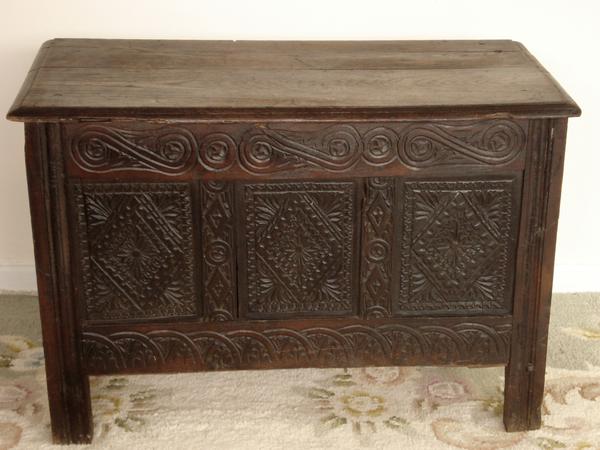
There are 3 main methods for removing old layers of paint or varnish covering furniture:
- sanding
- sandblasting
- dry cleaning
Polishing is similar to wood, with white grinding. Use coarse sandpaper, 60 and 80 grit. It can be done manually or by machine. Hand sanding is labor-intensive because the varnish has set well over time and is not very easy to remove. By hand, however, it is easier to get into narrower or hidden spaces, and abrasive materials can be adapted for such places (abrasive sponges, narrow abrasive belts).
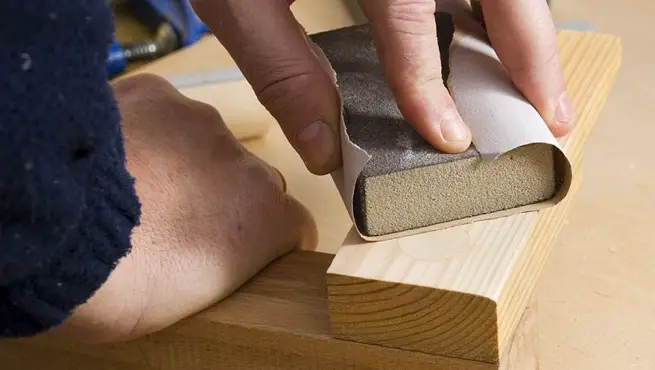
Mechanical sanding greatly reduces the effort as the machine does all the work. You can use small hand-held machines or industrial belt sanders. It's a useful method for large flat surfaces, but harder to use when you have objects with curves, carvings, millings or patterns that prevent the machine from reaching the wood.
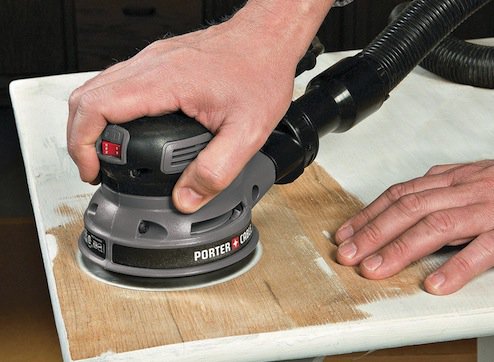
After the paint layer has been removed, the surface is wiped with paint thinner to remove any remaining traces. The wood is then sanded just like the white sanding, using finer sandpaper - 150 or 180 - to remove the raised grain and prepare the wood for the next finish.
Disadvantages of sanding are the high consumption of labor and materials (sandpaper and sanding pads clog quickly and need to be replaced for sanding to be effective) and the inability to reach hidden and very narrow places.
Sandblasting was originally used to clean metal of rust and old layers of paint. Over time the method found its way into the woodworking industry and was used not only to clean old finish coats but also to wood structuring. In fact, it is now mainly used for this purpose, with the wood the appearance of someone who has been outside for a long time (like old fence boards).
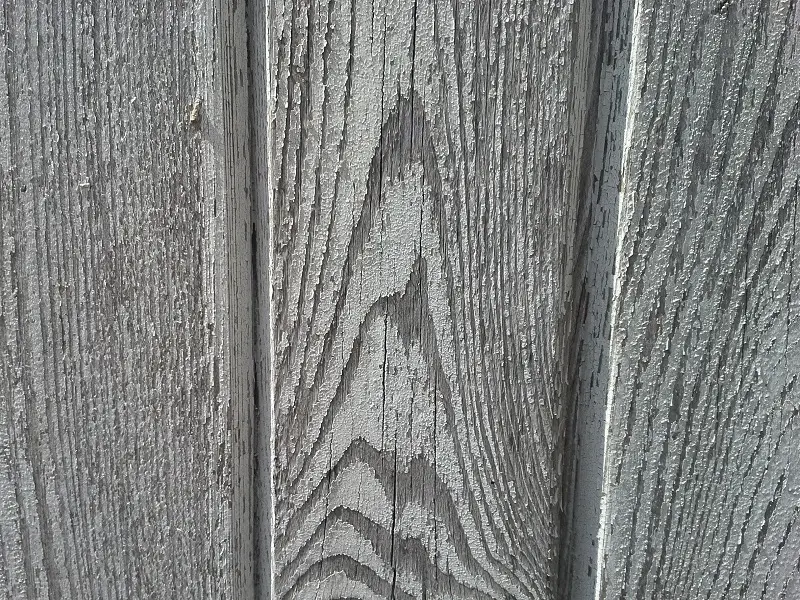
This is also abrasive cleaning, only in this case fine abrasive granules are sprayed onto the surface to be cleaned using a special gun. The cleaning is done very well, after which the wood remains clean and smooth, without the need for further white sanding. Sand is mainly used as a blasting agent, but other materials (walnut shells, small corn, etc.) can also be used.
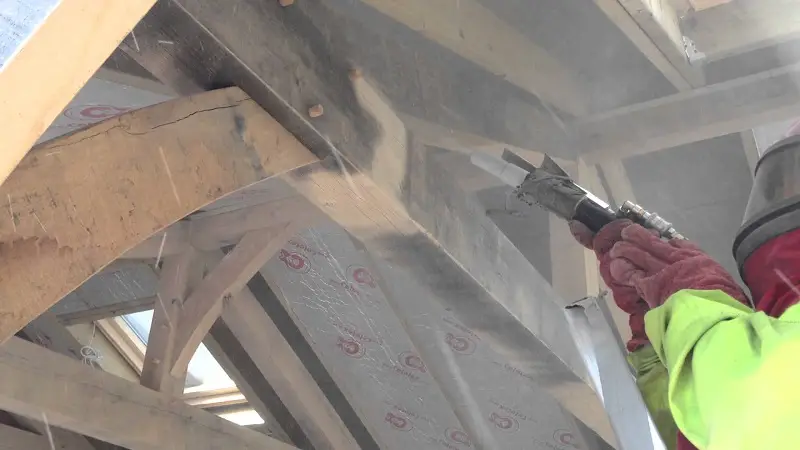
The disadvantage of this method is that special equipment is needed, and the sandblaster must be properly equipped and trained.
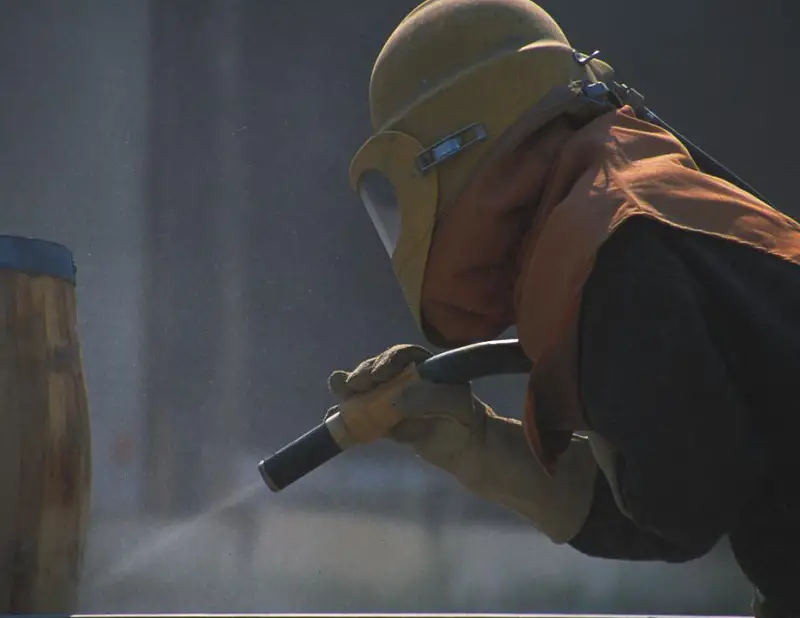
Chemical cleaning involves a chemical action on the paint layer, not a mechanical one as above. Solvents - more or less aggressive - or even more aggressive substances such as acids (derivatives of hydrochloric acid) or bases (caustic soda) are used to soften the old paint layer and make it removable. For DIY projects, you can find paint strippers in DIY stores that are moderately aggressive so that they can be used without great risk.
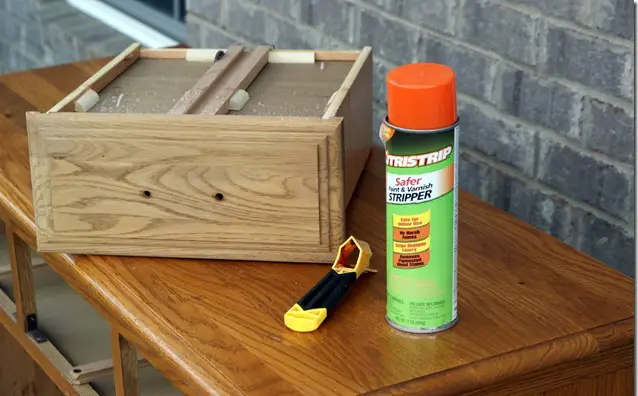
The way of working is simple. The paint stripper is applied with a brush to the painted surface and left to work for a while. If the substance is aggressive, a few minutes is sufficient. If it is a very slow solvent you will need to leave it on for 10-12 hours, maybe even 24. It will soften the layer of paint, which you then clean off with a scraper. You can also use a spackle. When the substance is aggressive, the paint layer also swells, so removal is easier. With thinner, it only softens.
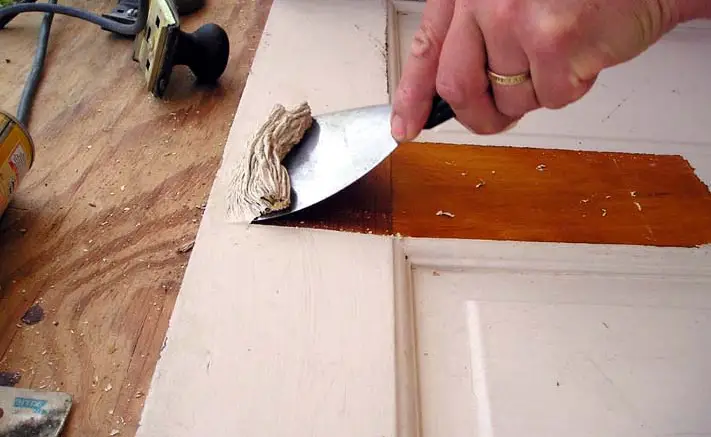
If the layer has not been completely removed the first time, the operation can be repeated 2-3 times until total removal. After that the surface is wiped with a cloth soaked in thinner, then sanded as for white sanding. If dark stains remain on the surface and you want to remove them use wood bleaching and discoloration methods.
CAUTION: If you have used special paint strippers, you may need to neutralize afterwards. The substance used should have instructions for use and tell you what to neutralize the substrate with so as not to affect the future finish coat.
In addition to these methods the paint can also be removed with a wire brush, by heating with a heat source (hair dryer) and removing the soaked layer with a squeegee or by direct burning with a burner. They are less commonly used, however, with the 3 above being the most common.
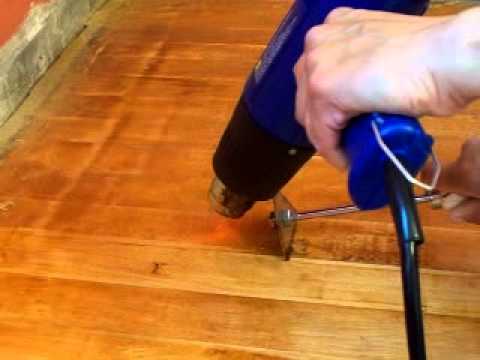
If you have correctly and totally removed the old coat of paint then the wood is ready for a new experience. It is like a clean new canvas waiting for its painter. Good luck!


























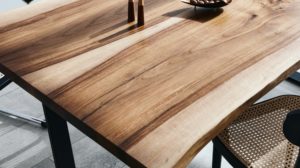






Hello!
I sanded a pine wood table, given a colourless varnish, with 60 grit sandpaper, then 120 grit sandpaper. The problem is that there are still many yellowish stains, I suspect that the wood has absorbed more varnish there, and I can't seem to remove them. Can you help me with some advice? I've tried thinner and bleach and it didn't work. Thank you!
Hello I would be interested in how I can remove the old varnish from a body of a church.It is natural oak, varnished with a varnish that has more matte areas and more "normal" areas.I can not use spatulas or spaclu because the surfaces are uneven (carving), also can not use enamel because it spoils the facets of the sculpture.Just something chemical and without water.Water can create tension and can crack the carving, in thin areas .... Thank you for your answer.
I have worked with many things with wood and wood, but with carved wood I have no experience in restoration.
Hello.
It's hard not to use a spatula or a spackle because the thinner or chemicals just soften the old paint, and then it has to be removed. There is no substance that will make the paint disappear or so fluid that it will flow on its own. The best solution for heavily sculptured surfaces is sandblasting, but you need a special gun. There are companies that recondition old furniture and use this method to remove the varnish layer.
All the best!
Don't forget to subscribe to the printed Wood Magazine! For only 58 lei/year you can find out news in the field, discover craft ideas or trade secrets. We remind you that the content in the printed magazine is different from the one on the website. Details in the link below.
Thank you!
https://revistadinlemn.ro/product/abonament-revista-din-lemn/
I am very familiar with the process of re-curing old wooden furniture or chair and other wooden surfaces.
From experience and from several discussions with specialists in the field, SANDBLASTING is one of the most effective methods, but the VORTEX nozzle is recommended as a sandblasting system, which spreads the material granules in a helical movement so that the cleaning is as fine as possible and the paint or varnish can be removed layer by layer.
after the chemical removal of the old paint, can it be repainted or will the surface have to be washed thoroughly so that the substance does not act on the new paint?
Hello.
It is good to wash the surface with thinner (universal thinner) because it is possible that there is debris that will react with the new paint. Wipe the entire surface with a cloth or sponge with thinner (a thinner-resistant sponge) 2-3 times and let it dry thoroughly. Then you can apply the new paint. For a smooth surface it would be better to sand the surface.
Good luck!
Hello!
I have purchased a set of collectible wooden chess pieces.The white pieces,unfortunately,are painted with a beige/cream paint.I would like to clean this paint.Unfortunately,sanding is not a solution,since they are curved surfaces with fine areas on a soft wood.What do you advise me to do? Thank you !
Hello.
Try it with a cloth with universal thinner. If the paint takes, keep going until you reach the wood, then sand the wood with fine abrasive sponges and repaint with white paint.
If paint thinner doesn't work, try paint stripper. DIY or specialty stores carry such products. Apply with a brush on the piece and let it work for 10-15 minutes. Then try to remove the layer with a chisel or a fine screwdriver. Repeat the operation until it is completely removed. Finally wipe the wood with thinner, sand and repaint.
You can also try soda. It attacks most varnishes and paints. In the online shop Clever find soda and directions for use to remove paint layers.
All the best!
https://iscusit.revistadinlemn.ro/ro/intreinere-lemn/47-soda-kreidezeit.html
Don't forget to subscribe to the printed Wood Magazine! For only 58 lei/year you can find out news in the field, discover craft ideas or trade secrets. We remind you that the content in the printed magazine is different from the one on the website. Details in the link below.
Thank you!https://revistadinlemn.ro/product/abonament-revista-din-lemn/
Hello.I have a pine wood surface that has been varnished.I would like to renew it with a water-based paint. Is it advisable to remove all the varnish before the wood is clean? Is it advisable to wipe the surface with technical alcohol before painting for better adhesion? What would you advise?
Hello.
There is no need to remove all the previous finish if you are painting furniture. The important thing is to degrease it, i.e. wash it with water and detergent, then wipe it well and leave it to dry well. If you are using a cream paint (Annie Sloan) you can apply it without sanding the surface. The paint has adhesion. After applying the paint you will need to "seal" the surface with wax.
If you are painting with another type of water-based paint (the kind you can find in DIY stores), you need to lightly sand the surface of the furniture (after degreasing it) so that the paint has adhesion. You don't have to get to the wood, but create small curls on the varnished surface of the furniture with a fine abrasive sponge or 280 or 320 grit sandpaper. These curls will catch the coat of paint you apply. For a good coverage you should apply at least 2 coats. These paints do not need wax as a final coat.
All the best!
Don't forget to subscribe to the printed Wood Magazine! For only 58 lei/year you can find out news in the field, discover craft ideas or trade secrets. We remind you that the content in the printed magazine is different from the one on the website. Details in the link below.
Thank you!https://revistadinlemn.ro/product/abonament-revista-din-lemn/
Hello!
I discovered with great pleasure your site, I learned a lot. I have a cottage in the country and decided to clean the original windows/doors of paint. The layers of paint came off relatively easily with the hot air blower, but under the classic paint I found a pesky layer of something blue chalk-like that turns plasticine under hot air and seems to penetrate, dilutes into the wood grain. On this layer the classic oil based paint does not stay, it salts. I managed to clean a door with wire sponge and stove detergent, with smirghel does not work because it sinks fff quickly, the question is can you recommend a more effective solution? The carpentry/paint should still be 80-90 years old. I would like to leave the wood grain exposed. Thanks!
Hello.
You gave me a hard time. 🙂 I keep thinking what that substance could be, especially since it's so old. I'm thinking a natural rubber derivative or a coating resulting from the interaction of wood resins and tannins with paint oil.
Try to cool, not heat that layer. If you say it is similar to chalk it may become brittle on cooling and can be easily removed with a brush (wire, if possible) or coarse sandpaper.
If it is a natural rubber derivative it should be removable with white spirit (petrosin) or even petrol.
Another option would be to use a paint stripper (Decanol) that you apply with a brush, let it work and remove with a scraper. You can also try a 2:1 solution of water and soda (with gloves as it is aggressive). The latter may blacken the wood.
The colour intrigues me. In the old days they used to use a solution made of tar and white spirit for staining. The factory called it P43 and it was perfect for staining oak. From the pitch there could be all sorts of residues, but not the colour mentioned.
It's what comes to mind now. If anything else comes up, I'll be back.
All the best!
Hello. I have an exterior wainscoting on the eaves of a house covered with a cherry coloured wood stain and I want to bring back the original colour of the wainscoting so that I can then apply a water based fir coloured stain, much lighter than the cherry. How could I do this? What method do you recommend? Thank you.
Hello!
If the wood is covered with a film (varnish, paint) use a paint stripper that you apply with a brush, let it work for a few minutes and then remove the soaked layer with a spackle. You can find such poduses in DIY or specialist shops (Decanol, for example). After removing the layer, wash with a cloth with thinner and sand until you reach clean wood. If the cherry-coloured filler has penetrated deep into the wood, manual sanding may not be sufficient and you may need a sanding machine (orbital or flat). Finally sand with a fine sandpaper (180-220) and apply the desired finish.
If the wood has no film but is only stained, stripping is not necessary, sanding is sufficient.
All the best!
Good evening,
I want to restore some old windows painted in oil and I'm having a hard time.I tried sanding by hand and with the flex but it's very difficult,I tried to burn well with a burner and then sand that ash but the wood remains too black and again it's almost impossible to sand because it's difficult and I want the wood to remain its color and given with bait.Please give me some advice. Thanks
Hello!
If it is oil paint you can use lye or other substances containing alkaline substances. But you must be careful because the substance is aggressive and can burn the skin. Applying the lye over the paint will cause it to liquefy. Wipe off with a sponge and neutralize the surface with an acid (vinegar).
Or you can use commercial paint strippers. I used Decanol which I found in a DIY store. Apply it with a brush, leave it to work for a while, then remove the soaked layer with a squeegee. Finally sand and wipe off with thinner.
All the best!
You can also find out more about your favourite topics in printed magazines. You can still subscribe to receive magazines published in 2019 by clicking on the link below.
Thank you!
https://revistadinlemn.ro/product/abonament-2019/
Hello
I have to paint the doors and their frames in an apartment. I started to sand the first door manually and mechanically .... and I saw that it has 5-6 coats of paint, one coat simply sticks and another coat sticks to the enamel.
Can you help me with some advice? Thank you.
Hello!
Try a paint stripper. I worked with Decanol (Policolor) and it worked well. You can find it in DIY stores. Apply with a brush, let it work for 15-20 min, then remove the wet coat with a spackle. It should work on all types of paint applied over time. You can repeat the operation until the old paint layer is completely removed.
Another good stripper is caustic soda solution, but it only works on oil-based (alkyd) paints and here it looks like you have different paints. It's very good for oil based paint, it liquefies it plain and simple.
You can also try softening the coat with a hair dryer. I don't think chemical hardening varnishes were used. If it was oil-based paints and nitrocellulose paints, the coat will soften and you can remove it with a squeegee.
All the best!
Hello,
I want to paint a door and door frame, then paint them with varnish. How should I proceed?
Thank you for your reply.
Hello!
I would combine 2 methods, pickling and heating with a hair dryer. For the door, because it has a straight surface (I assumed it did), I would use the blow dryer to heat the surface after which I would remove the paint layer with a new paint stripper (so that the edge is straight and sharp). If necessary, it can be repeated. At the end wipe it all off with a rag soaked in thinner and sand along the grain with a medium abrasive sponge. For the holster, because the shape is more difficult, I would use paint stripper (I used Decanol, from Policolor, but there are other brands. You can find them in DIY stores). Apply it with a brush, leave it to work for a while (the time needed is mentioned on the label), then remove it with a spackle. Use a narrow gap to reach into narrow spaces. In hard-to-reach areas try with a rag with thinner or by sanding. Finally wipe everything with thinner and sand with a medium abrasive sponge.
If the surface looks good, you can proceed to varnishing. Be careful, the varnish will access the defects. If you don't like the look try to improve it or use paint.
To avoid unpleasant odours, use water-based varnish. After drying the first coat, sand the entire surface with a fine abrasive sponge. You will remove the wood grain that has been raised by the water absorption of the varnish and you will obtain a smooth surface. Then apply 1-2 coats without sanding. Do not apply thick coats as it may crack over time. Thinner and more coats are better.
Good luck!
Hello! these processes can be used on mdf? i have 40 years old doors at home and i want to paint them, but for that i have to get rid of the old paint. thanks!
Hello!
Yes, they can also be used for MDF, with the caveat that MDF sanding is much less than wood sanding. If you insist, you end up with a more porous layer and the absorption inside will be more accentuated. An additional layer will probably be needed and the first layer applied will have to be sanded to remove roughness. Sanding is done with a fine abrasive sponge or 280 or 320 grit sandpaper.
All the best!
Hello! I just painted part of the paneling on an outdoor cottage with 3 in 1 lacquer and I'm not thrilled with the color. Can I remove it with paint stripper? I'm afraid that the paint has already gotten into the wood and there's nothing I can do to it.
Hello!
Yes, you can. Even easier because it's fresh paint. It is possible that the wood will remain a little stained because it has absorbed a small amount of material. It shouldn't be bothersome. If the color is too different from what you are going to apply, you will need to sand the wood with 120 or 150 grit sandpaper or a coarse sanding sponge. The colour is only on the surface and sanding will remove it.
Good luck!
https://revistadinlemn.ro/2019/04/18/greseli-din-exces-de-zel-la-slefuirea-manuala-a-lemnului/